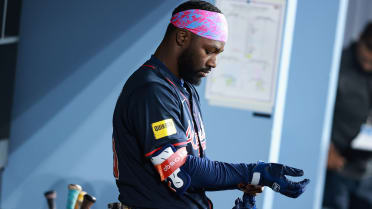Are the D-backs the best team in baseball? That requires a subjective answer, but you can’t dispute that they have been the game’s hottest squad for an extended period.
Since July 7 -- that date will seem a little less arbitrary in a minute -- the D-backs’ 31-11 record is the best in the Majors. Riding a six-game winning streak, their playoff chances have more than tripled since July 7, leaping from 31.8% to 96.1%, according to FanGraphs. They own the No. 1 National League Wild Card but are also on the heels of the first-place Dodgers in the division. Arizona has shaved 7 1/2 games off of its NL West deficit over this 42-game stretch and has an opportunity to gain more ground this weekend when it welcomes the Dodgers to Chase Field for a four-game set.
What’s behind this success? If we have to put a finger on one thing, it has got to be the lineup, which has averaged an MLB-best 6.33 runs per game. Thirty-nine players with at least 100 plate appearances have registered an .875 OPS or better during this span, and six of them are D-backs.
That includes Joc Pederson, Jake McCarthy, Eugenio Suárez, the currently injured Ketel Marte, and Josh Bell, who was acquired via trade from the Marlins on July 30.
But we’re here to spotlight the sixth member of that group: Corbin Carroll
The 2023 NL Rookie of the Year, Carroll was a catalyst for the pennant-winning D-backs last season. He became just the third player in the Wild Card Era (since 1995) to hit at least 25 homers and steal 50 bases. He was one of the best young stars in the sport.
And then through the first three-plus months of this season, Carroll looked lost. He was batting .210 with a .298 on-base percentage. Even more alarming was his lack of power; Carroll hit just two home runs through his first 87 games, and his .310 slugging percentage was the second worst in the big leagues (min. 300 PA).
Carroll through July 6 (87 games): .310 slugging, two home runs, 10 barrels, 3.8% barrel rate
Then came July 7. Carroll led off that afternoon’s game by pulling an elevated 96.5 mph four-seam fastball from Padres ace Dylan Cease for a home run, his first in 54 games.
A dinger to right field off high velocity above the strike zone. That one pitch was very much a sign of what was to come, and Carroll has really tapped into his power since.
Carroll since July 7 entering Sunday (39 games): .604 slugging, 12 home runs, 11 barrels, 9.9% barrel rate
“I think his best baseball is being played right now,” D-backs manager Torey Lovullo said earlier this month.
What is behind this success?
“It's hard to put a finger on just one thing,” Carroll said.
We won’t put a finger on just one thing. Instead, here are three things that have helped the D-backs star rebound from his slow start to the season.
Stats below updated through Saturday.
1. Get it in the air
Analysis: Your chances of hitting a home run increase the more often you hit fly balls instead of ground balls. As you recover from receiving that piece of groundbreaking information, know that Carroll turned in a fly ball rate of just 16.2% through July 6. That would rank second to last among qualified batters today.
But the 24-year-old said he has found a more efficient swing recently, and it has contributed to improved batted-ball results.
Over this seven-week stretch, Carroll’s fly ball rate has soared to 31% while he has shaved nearly six points off his ground-ball rate (47.4% to 41.6%). Those extra fly balls are coming with about 4 mph more exit velocity than before, a 62.9% hard-hit rate and a 28.6% barrel rate.
And although Carroll has often homered either to the opposite field or to center, his power surge has been boosted by an influx of fly balls to his pull side. He pulled five of his 43 fly balls prior to July 7. Fourteen of 35 have traveled to right field since.
“I feel more comfortable letting the bat head get out in front of the plate a little more because I know it's not just going to be a hard ground ball to second base,” Carroll said. “It's a good, efficient swing where I'm entering the zone the way I want to, and then staying in the zone a little longer, not rolling over or kind of pulling out the zone early and causing that rolled-over ground ball.”
2. No pitch is too fast for him
Doing damage against fastballs was one of the many things Carroll excelled at during his rookie campaign. He slugged .521 against heaters, and his +18 run value versus all fastballs (four-seamers, sinkers and cutters) tied for 18th in the Majors.
This season, that run value has fallen to +5 due largely to troubles versus four-seamers. Carroll’s production against that pitch type has taken a drastic downturn, highlighted by a .174 average and a nearly .300-point drop in slugging percentage (.576 to .281). His run value on four-seamers has gone from +12 to -9, among the lowest in baseball.
So, has Carroll returned to his old ways against four-seamers? Actually, no. Even during this hot streak, he’s slashing .170/.339/.362 against that pitch. But that just doesn’t mean pitchers can blow their fastball by Carroll whenever they please. Cease found that out the hard way.
Even though Carroll’s overall production against four-seamers is down, his production against high-velocity fastballs is up. Way, way up.
2024 MLB average vs. 95+ mph pitches: .237 average, .696 OPS, 8.1% barrel rate
Carroll vs. 95+ mph pitches before July 7: .212 average (17-for-62), .563 OPS, one home run, 4.8% barrel rate
Carroll vs. 95+ mph pitches since July 7: .333 average (11-for-33), 1.269 OPS, five home runs, 16.0% barrel rate
For this, Carroll credits “being more stubborn to my zone.” He has focused on hunting pitches in a certain zone and not expanding too far outside of it. This approach leads him to shrink the plate and not chase a pitch beyond his established zone, even if it is a strike. That can result in more K’s -- Carroll’s strikeout rate has ticked up slightly over the past seven weeks -- but he accepts that risk because he knows he has a plan that works for him.
“I know that when I’ve gotten my best in the past, there have been strikeouts that come with,” he said. “I feel like that's almost part of a good process, like, ‘Hey, you're so committed to your plan that you're OK with taking the ball that might clip the corner.’ You start swinging at that ball and then things kind of spiral from there. I feel a little bit more dialed in.”
3. He is demolishing elevated pitches
Opposing pitchers had a big zone in which to attack Carroll earlier this season: Anything near the top of the strike zone and above.
“People were throwing it there, and he was having a tough time getting to it,” Lovullo said of his star outfielder.
And when he got to it, he didn’t do much with it. Carroll posted a .150/.301/.225 slash line with four extra-base hits in 120 at-bats ending on elevated pitches before July 7. Now, pitchers better throw it somewhere else because Carroll is putting up big numbers against such offerings.
Carroll on elevated pitches since July 7: .318/.475/.841 with 10 extra-base hits in 44 at-bats.
There is some BABIP luck in this area (.185 entering July 7; .313 since), and Carroll’s expected numbers are significantly less than his output, hinting that a dose of good fortune is mixed into that gaudy slash line.
Still, Carroll felt like his swing was dragging at times during the early months. Fixing that as well as keeping his stride length under control are a couple of reasons why he is able to handle the high stuff.
“My arm isn’t barring out,” he said “My hands are getting away from my body early and then kind of just rotating from there. I feel like the swing has just been nice, tight and compact. Because of that, I'm able to get the swing off when I want to get it off instead of feeling like I'm fighting myself.”
Lovullo added: “The swing plane is right and the posture is right. The alignment of the lower half is in a good spot.”
What’s next?
Carroll and the D-backs are in a great spot as we approach the season’s final month. He’s back to being a triple threat who is making an impact with the bat, on the basepaths and in the outfield.
But the work never stops. Next on Carroll’s to-do list: Make sure he’s putting together quality plate appearances versus left-handers, who have held him to a .193/.272/.336 slash line this season and whom he knows he’ll see in crucial spots throughout the postseason. He has already made headway there, with three homers in 34 at-bats against left-handers since July 7. He entered that day with five career dingers in 319 ABs versus same-handed hurlers.
Once lost, Carroll has found what works for him at the plate, and his re-emergence has the D-backs looking especially formidable.
“I felt like I was in a place where I was searching for a long time there," Carroll said. "Now finally having some cues and some feels that I go to the ballpark every day and feel like I give myself the best chance to help the team.”
Brian Murphy is a reporter for MLB.com.




